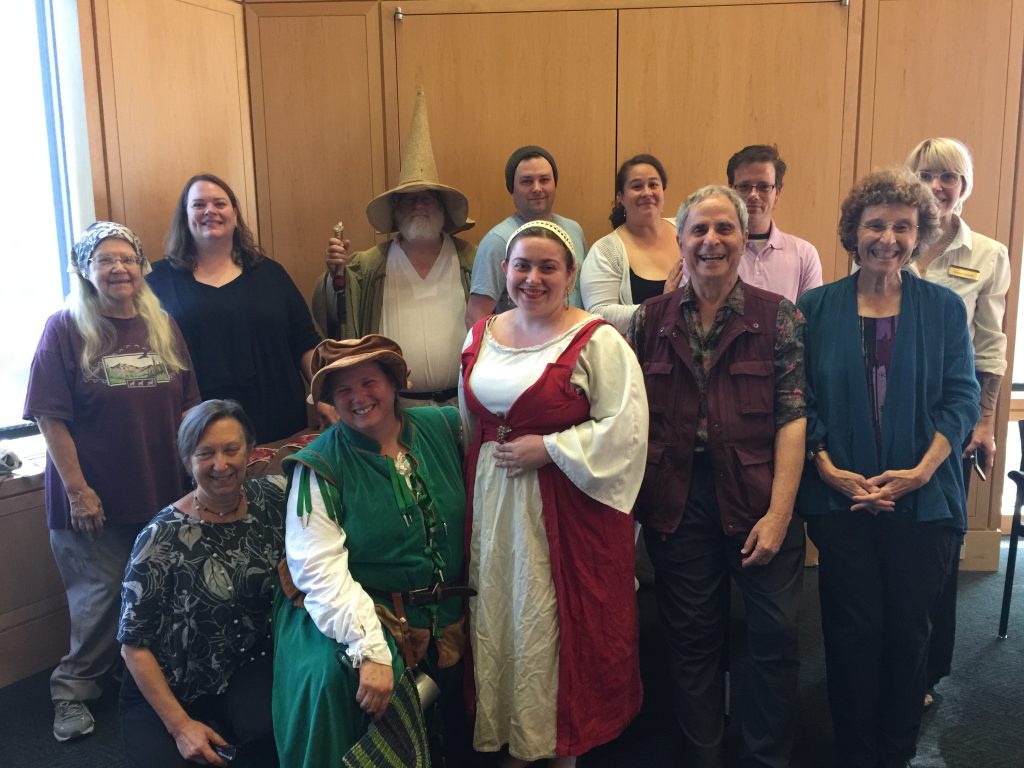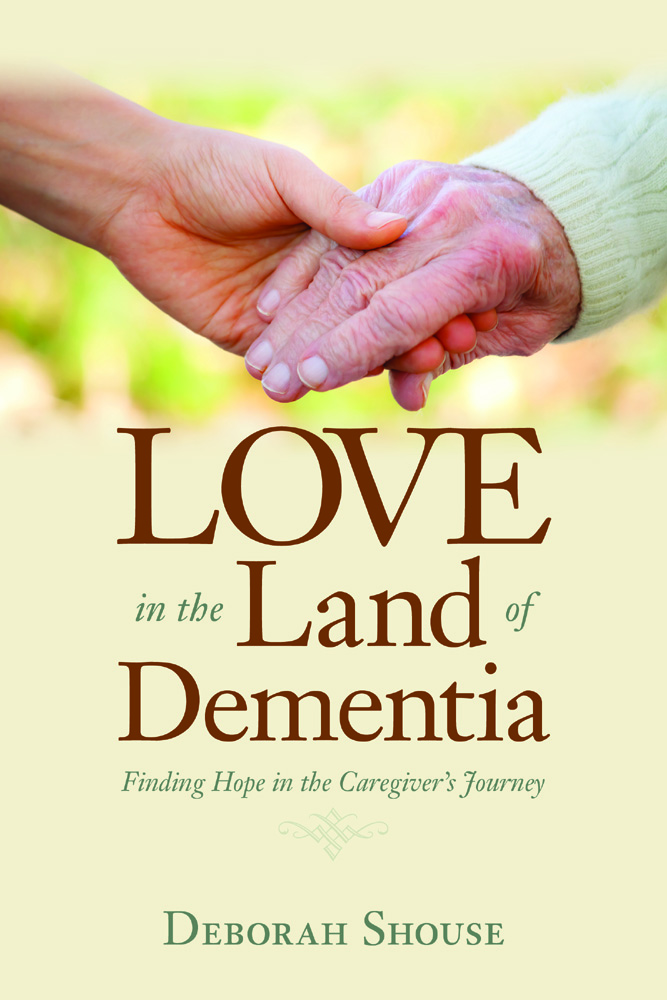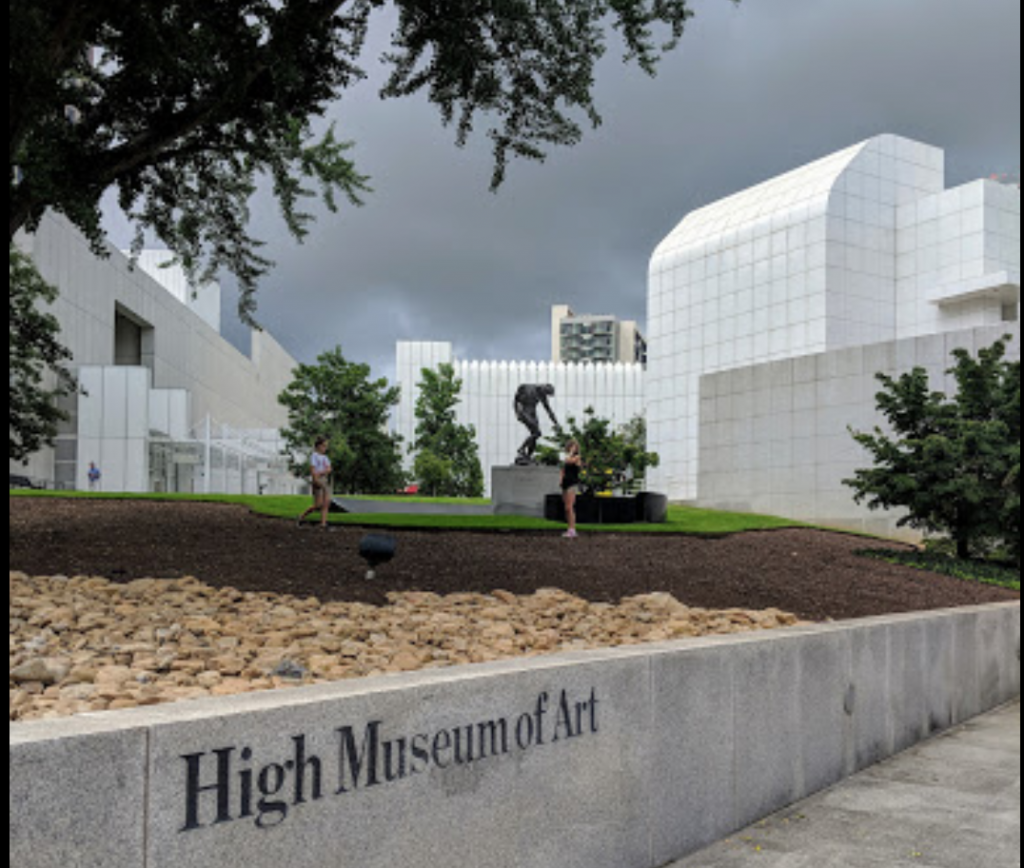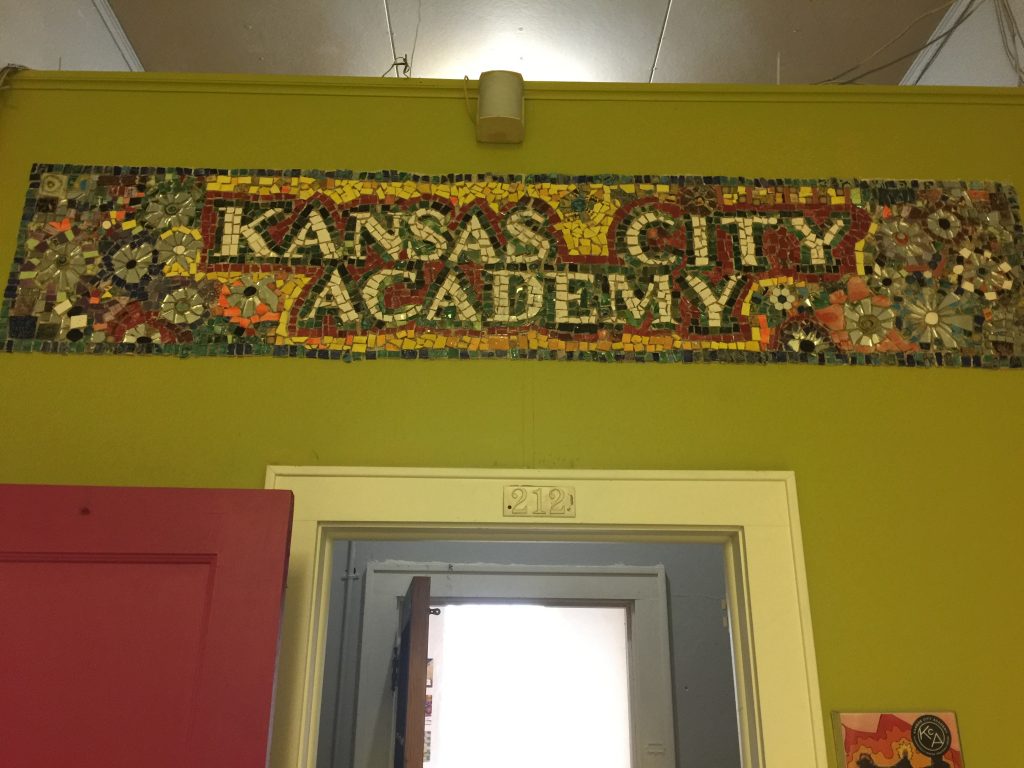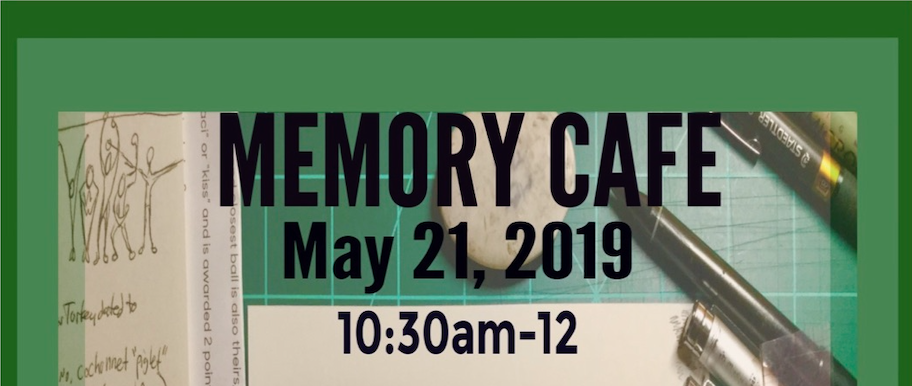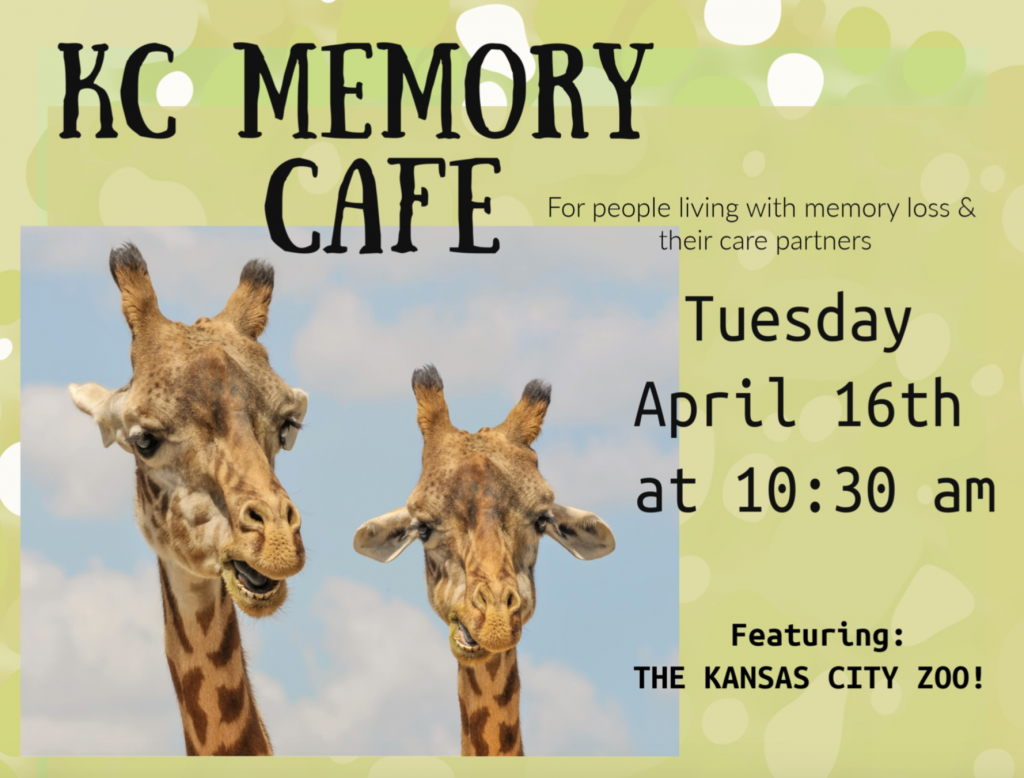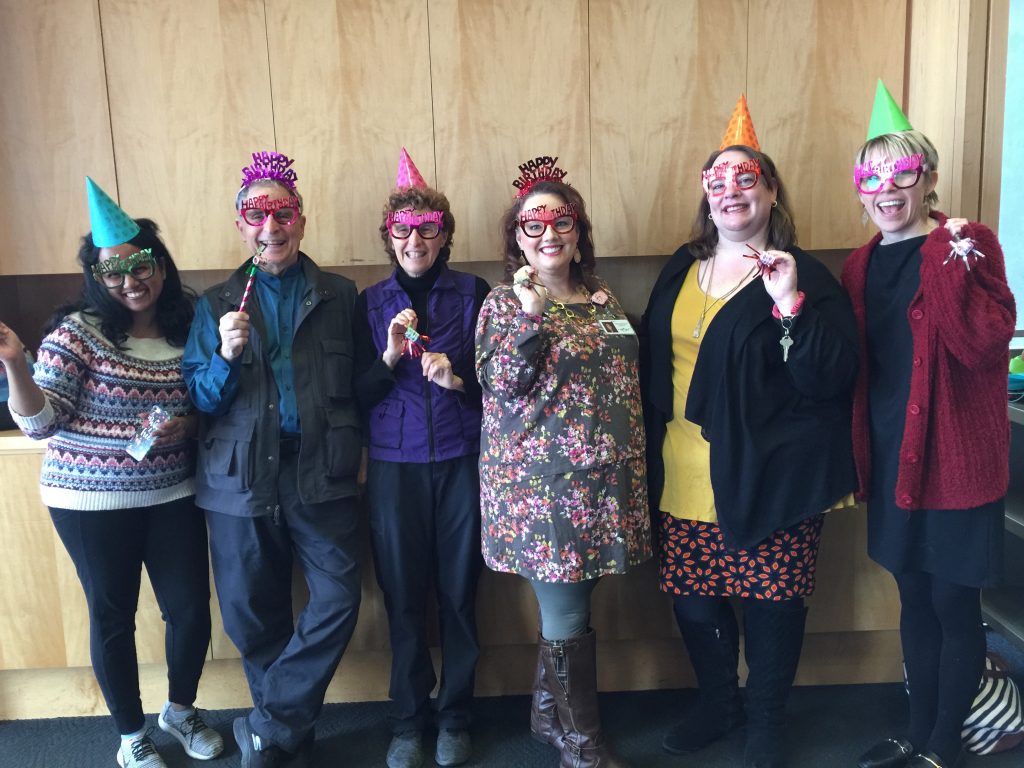Posts Tagged ‘Alzheimer’s Dementia’
Huzzah! RenFest Stars Present at KC Memory Cafe
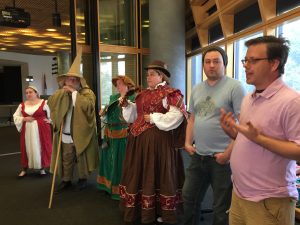 A wizard, a peasant, a royal hat maker, and a royal candy maker walked into the Plaza Library. But they were not here to check out books on their respective trades: they were with several other RenFest stars, eager to present at the KC Memory Cafe.
A wizard, a peasant, a royal hat maker, and a royal candy maker walked into the Plaza Library. But they were not here to check out books on their respective trades: they were with several other RenFest stars, eager to present at the KC Memory Cafe.
Mia Moore shared the inside story of getting into her complicated costume as the Renfest character of Molly William, Lady Steward of the Household. First, she slipped on a gauzy white under-blouse with an appealing ruff around the neck. Then, she created a luscious hour-glass shape by putting on a corset. In the olden days, the corsets were made with whale bones. But Mia was ecologically correct and chose industrial cables for hers. A wide brown skirt, made of upholstery materials, was next, followed by a lady’s doublet, with dozens of small fabric covered buttons. Getting all buttoned up took at least ten minutes, and she kept us quite entertained throughout the process. Her final adornment was a jaunty hat.
Click here to get the RenFest inside story.
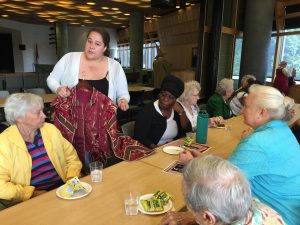 “It wouldn’t be proper to go around with my hair uncovered. Plus, during the Renaissance, people didn’t bathe that often. Their hair might be dirty and lice-ridden, which the hat kindly covered,” she told us.
“It wouldn’t be proper to go around with my hair uncovered. Plus, during the Renaissance, people didn’t bathe that often. Their hair might be dirty and lice-ridden, which the hat kindly covered,” she told us.
As each of the performers shared information about their characters, we could feel their passion for history and for this fascinating time period.
The wizard assured us, he would never walk about London with his high pointed burlap hat and his quartz-topped staff; for that, he would have been locked up in a mental hospital. Instead, he would have lived in a rural setting and been considered an alchemist. The peasant told us, “The amount of cloth in a middle class woman’s skirt would be enough for me and my family for a year.”
Cloth was quite valuable and all fabrics were recycled and passed down, mended and amended until they were nothing but scraps.
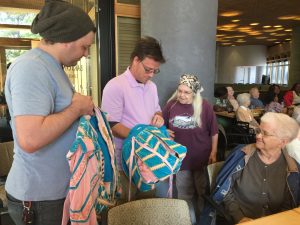 How often does a person have a chance to touch an ostrich feather fan or stroke the soft pink velvet of the royal candy maker’s doublet? Our performers walked about the room, greeting individuals, sharing stories about their characters and clothing, and letting us examine their specially made costumes.
How often does a person have a chance to touch an ostrich feather fan or stroke the soft pink velvet of the royal candy maker’s doublet? Our performers walked about the room, greeting individuals, sharing stories about their characters and clothing, and letting us examine their specially made costumes.
It was a glorious experience, rich with history, energy, and imagination.
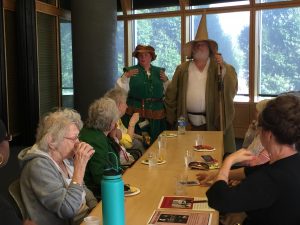
Click to view informative and inspiring short videos on our YouTube channel
Deborah Shouse is the author of Connecting in the Land of Dementia: Creative Activities to Explore Together and Love in the Land of Dementia: Finding Hope in the Caregiver’s Journey.
The Beat Goes on at KC Memory Cafe
 “Drumming ultimately has therapeutic value, providing the emotional and physical benefits collectively known as “drummer’s high,” an endorphin rush that can only be stimulated by playing music, not simply listening to it. …The endorphin-filled act of drumming increases positive emotions and leads people to work together in a more cooperative fashion.” The Neuroscience of Drumming
“Drumming ultimately has therapeutic value, providing the emotional and physical benefits collectively known as “drummer’s high,” an endorphin rush that can only be stimulated by playing music, not simply listening to it. …The endorphin-filled act of drumming increases positive emotions and leads people to work together in a more cooperative fashion.” The Neuroscience of Drumming
Want to experience your own drummer’s high?
Click here and tap along to the beat.
The beat goes on at KC Memory Cafe. Brandon Draper of Drum Safari reminds us how connected we all are by tapping his hand on the table. “No matter where we come from, we all share this internal rhythm, our heartbeat,” he tells us. We tap along with him, and follow his lead as he introduces other more complex beats. Ninety of us are gathered on the lower level of the Plaza Library to experience the magic of drumming, guided by Brandon, his wife, and two daughters. He introduces us to ancient drums and to contemporary instruments. After our briefing in the powerful history of drumming, we all have an opportunity to experience the “drummer’s high.”
The excitement and energy in the room builds as we all make music together. We  are laughing, banging away, singing call and response, and thoroughly engaged in creating cooperative sounds.
are laughing, banging away, singing call and response, and thoroughly engaged in creating cooperative sounds.
People lingered for a long time afterwards, drawn together by the shared experience.
Though Brandon has shared his drumming skills many times, performing at the KC Memory Care touched him deeply. He was thinking of his beloved grandmother, who had lived with dementia. He stayed connected with her through music. “To be here, sharing with all of you, meant so much to me,” he told us.
Our thanks to the wonderful team from Santa Marta Retirement Center, who nourished us with delicious snacks and helped serve everyone. Thanks also to Pam and Beverly, who helped nurture, serve, encourage and keep the beat going on. Want to volunteer or get on our email list? Just contact Heather Harrison, heatherharrison@kclibrary.org 816-701-3763

Click to view informative and inspiring short videos on our YouTube channel
Deborah Shouse is the author of Connecting in the Land of Dementia: Creative Activities to Explore Together and Love in the Land of Dementia: Finding Hope in the Caregiver’s Journey.
Musing Together: Looking at Art Expands Skills, Increases Socialization, and Widens Horizons
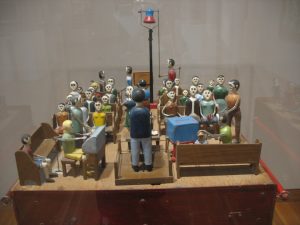 The group pauses in front of a large contemporary sculpture, depicting a preacher standing before his congregation at a small country church. They walk around the piece, noticing the pews, the organist, and the variety of parishioners, and chatting as they view. Then they settle into chairs and co-facilitator Esther Smith asks: “What is one word that comes to mind when you look at this piece of art.”
The group pauses in front of a large contemporary sculpture, depicting a preacher standing before his congregation at a small country church. They walk around the piece, noticing the pews, the organist, and the variety of parishioners, and chatting as they view. Then they settle into chairs and co-facilitator Esther Smith asks: “What is one word that comes to mind when you look at this piece of art.”
“Boring,’ says one woman.
“What makes it boring?” Esther asks.
“It brings me back to my childhood, when I was stuck in church for hours,” she answers. “I was so bored.”
A few others nod. Someone asks, “When was this made? Where is it from?” and the conversation about the art continues.
Every month at the High Museum in Atlanta, Georgia, Teaching Artist Esther Smith guides a group of care partners and people living with dementia on a 90-minute gallery exploration called Musings Together.
“It’s a light-hearted, interactive experience,” Esther says. “We go at a slow pace, seeing only three to four works each time. We want people to have a comfortable, personalized experience with art.”
 The open-ended conversation brings out people’s stories and ideas. Sitting in front of Giovanni Bellini’s Madona and Child, Esther asks, “What lines do you notice in this painting? Trace them in the air with your hand.”
The open-ended conversation brings out people’s stories and ideas. Sitting in front of Giovanni Bellini’s Madona and Child, Esther asks, “What lines do you notice in this painting? Trace them in the air with your hand.”
After people trace their lines, she asks, “What line was most interesting to you?” That question might lead into a discussion of what makes this painting different. Then Esther might invite the group to pose like the picture. She might say, “How would that baby’s head feel in your hand?”
“These simple prompts launch us into deep conversations,” Esther says. She and her team are experimenting with expanding the sensory experience, including bringing out oranges when they’re gazing at a still life of fruit and letting each guest hold and examine the orange. Esther also invites people to occasionally sketch an aspect of a drawing that appeals to them, using a drawing pad on a clipboard.
“ A number of our participants have never been regular museum-goers. Now they feel comfortable here and come more often,” Esther says. “Developing a new community of friends and an expanding interest in art enriches their lives.” #
Want to look at art with someone who is living with dementia?
If you’re visiting a museum, focus on a gallery with 3-4 large and interesting pieces. Ask a docent for advice, if needed. If you’re at home, give yourself plenty to time to comfortably view a few works of art on-line or in books.
- Bring a folding chair, so you can sit.
- Chose a time of day when your partner is energetic and the gallery is relatively quiet.
- Have fun just noticing the aspects of the piece. You might invite comments on colors, textures, familiar figures, objects that seem odd to you, and other aspects.
- Ask open-ended questions, such as, “What does this piece make you think of?” “What do you like about this piece?” “How do you think that main guy feels?”
When attention wanes, move onto something else, including a lovely coffee or tea break.
Click to view informative and inspiring short videos on our YouTube channel
Deborah Shouse is the author of Connecting in the Land of Dementia: Creative Activities to Explore Together and Love in the Land of Dementia: Finding Hope in the Caregiver’s Journey.
A Dream Came True at The Red Ballon Movies & Memories
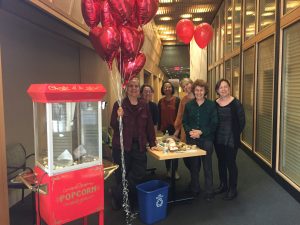 “I wish I had a red balloon,” one of our guests said, after the inspiring ending of the short film, The Red Balloon. Moments later, the dream came true. Each guest was offered a buoyant scarlet balloon, the magical symbol of a meaningful film.
“I wish I had a red balloon,” one of our guests said, after the inspiring ending of the short film, The Red Balloon. Moments later, the dream came true. Each guest was offered a buoyant scarlet balloon, the magical symbol of a meaningful film.
The Movies & Memories program now has a new time and date: the first Wednesday of each month from 10:30-12:00.
As guests enter the lower level of the 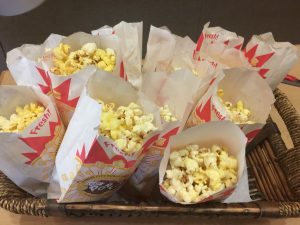 Plaza Library, they breathe in the enticing aroma of fresh popcorn. Soon, they are settled in comfortable chairs and munching on popcorn and cookies, while being serenaded. They sing along with Richelle Basgall, who engages them with fiddle, guitar, kazoo, and more. They tap their feet and clap their hands, belting out favorite folk songs and old standards, such as Ol’ Suzanna, Que Sera Sera, and I’ve Been Working on the Railroad.
Plaza Library, they breathe in the enticing aroma of fresh popcorn. Soon, they are settled in comfortable chairs and munching on popcorn and cookies, while being serenaded. They sing along with Richelle Basgall, who engages them with fiddle, guitar, kazoo, and more. They tap their feet and clap their hands, belting out favorite folk songs and old standards, such as Ol’ Suzanna, Que Sera Sera, and I’ve Been Working on the Railroad.
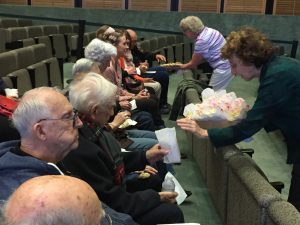 Then the lights lower and everyone watches intently as a young boy and his red balloon form a deep bond, and stick together, despite many obstacles. People were still talking about the movie as they and their balloons trail down the hallway, heading towards home.
Then the lights lower and everyone watches intently as a young boy and his red balloon form a deep bond, and stick together, despite many obstacles. People were still talking about the movie as they and their balloons trail down the hallway, heading towards home.
Get a taste of The Red Balloon movie event by clicking here.
Many thanks to our wonderful volunteers, including Sharon, Julie, and Pam. And special thanks to Sharon and Elizabeth from Stonecrest for bringing delicious snacks for us.
Our next movie experience is on July 3rd. Please join us for Room on the Broom, and other short films, a celebration of diversity. You’ll love the songs from Robert Gibby Brand, our featured musician.
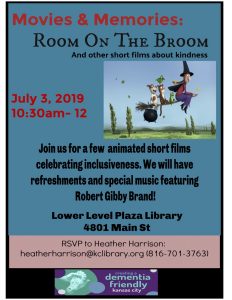
Click to view informative and inspiring short videos on our YouTube channel
Deborah Shouse is the author of Connecting in the Land of Dementia: Creative Activities to Explore Together and Love in the Land of Dementia: Finding Hope in the Caregiver’s Journey.
The Stamp of Fundraising for Dementia: Kudos to Lynda Everman and Kathy Siggins
I am always delighted to get an update from Lynda and Kathy. For years, they promoted the idea of a semi-postal stamp for Alzheimer’s, a stamp that would cost a little more and raise money for the cause. They had to be persistent, dedicated, connective, tireless, creative, and patient. They were.
Their stamp was brought out in November 2017. I was one of the many who were elated. Those are the stamps I buy. I feel joy each time I mail a letter with that semi-postal, knowing that I am raising awareness and money.
I am sending Lynda’s recent updates. I hope you’ll join me in ordering more stamps right now and in encouraging your representatives to support this stamp, as they can extend the life of the stamp. Lynda and Kathy are an example of how two people, enlisting the support of hundreds of others, can make a dramatic difference. Follow your heart into making your own difference.
Warmly,
Deborah
From Lynda:
As of the end of February, 6 million Alzheimer’s stamps have been sold to raise $840,000 for NIH funded dementia research: https://about.usps.com/corporate-social-responsibility/semipostals.htm
 The sales period for the Alzheimer’s semipostal stamp is time-limited…. The Alzheimer’s stamp which was first issued on November 30, 2017 will be removed from sale on November 30, 2019.
The sales period for the Alzheimer’s semipostal stamp is time-limited…. The Alzheimer’s stamp which was first issued on November 30, 2017 will be removed from sale on November 30, 2019.
Let’s see what we can do to EXCEED $1 million raised for NIH funded Alzheimer’s research by November 30th! Please keep purchasing and promoting the stamp which is available at most post offices, online at https://store.usps.com/store/product/buy-stamps/alzheimers-S_564204 and by toll-free phone order at 1-800 STAMP-24.
Here’s another update:
Hello friends,
I am using this tremendous resource from the Alzheimer’s Impact Movement (AIM) to reach out to the health legislative staff of all 535 members of Congress urging all to co-sponsor legislation (H.R. 3113 and S. 1728) requiring the USPS to extend sales of the Alzheimer’s Disease Research Semipostal Stamp for an additional 6 years.
But I need your help! If you’ve not done so already, would you please call or email your Congressperson and Senators and ask for their support? Below are sample scripts/emails for you to use.
FOR CONGRESSPERSONS:
Request to Co-sponsor H.R. 3113
I want to to call attention to proposed bipartisan, bicameral legislation which, if passed, would extend the sales of the US Postal Service Alzheimer’s Disease Research Semipostal Stamp for an additional 6 years.
In less than a year and a half on the market, the Alzheimer’s Stamp has raised over $890,000 for NIH funded research for better treatments, prevention and, one day, a cure for these diseases which have caused too much suffering for far too long. However, despite the fact that 500 million stamps were printed (of which 6.5 million have been sold), without this legislation, all unsold stamps will be removed from sales at the end of November. The passage of this legislation will not increase the Congressional Budget; but it will allow all who use the U.S. mail to continue to voluntarily purchase these stamps to help raise public awareness and funds for critical research.
Please join your colleagues in co-sponsoring H.R. 3113 “To require the United States Postal Service to sell the Alzheimer’s semipostal stamp for 6 additional years.”
Thank you.
FOR SENATORS:
Request to Co-sponsor S. 1728
I want to to call attention to proposed bipartisan, bicameral legislation which, if passed, would extend the sales of the US Postal Service Alzheimer’s Disease Research Semipostal Stamp for an additional 6 years.
In less than a year and a half on the market, the Alzheimer’s Stamp has raised over $890,000 for NIH funded research for better treatments, prevention and, one day, a cure for these diseases which have caused too much suffering for far too long. However, despite the fact that 500 million stamps were printed (of which 6.5 million have been sold), without this legislation, all unsold stamps will be removed from sales at the end of November. The passage of this legislation will not increase the Congressional Budget; but it will allow all who use the U.S. mail to continue to voluntarily purchase these stamps to help raise public awareness and funds for critical research.
Please join your colleagues in co-sponsoring S. 1728 “A bill to require the United States Postal Service to sell the Alzheimer’s semipostal stamp for 6 additional years.”
Click to view informative and inspiring short videos on our YouTube channel
Deborah Shouse is the author of Connecting in the Land of Dementia: Creative Activities to Explore Together and Love in the Land of Dementia: Finding Hope in the Caregiver’s Journey.
Talking about Dementia with Teens
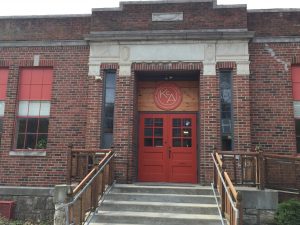 We were delighted to spend time with the bright and curious sixth and seventh graders in Mary Silwance’s class at KC Academy. They had read the young adult novel Hour of the Bees, which features a poignant relationship between a pre-teen girl and her grandfather who is living with dementia, and they wanted to learn more. During our short time together, talking about dementia with teens, we discussed:
We were delighted to spend time with the bright and curious sixth and seventh graders in Mary Silwance’s class at KC Academy. They had read the young adult novel Hour of the Bees, which features a poignant relationship between a pre-teen girl and her grandfather who is living with dementia, and they wanted to learn more. During our short time together, talking about dementia with teens, we discussed:
- How it might feel for people who are living with dementia
- Stigma and stereotypes
- Creativity and dementia
- Becoming an advocate
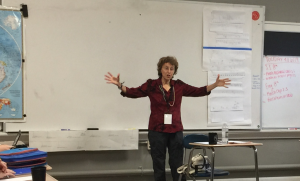 Here are a few excerpts from our lively conversation:
Here are a few excerpts from our lively conversation:
How many of you have ever misplaced something? How did you feel when you couldn’t find it?
How many of you have ever forgotten what you were going to say?
Have any of you ever overslept, woken up in a panic, and not known what day it was?
Those kinds of issues happen to most of us, at least occasionally.
But imagine how you would feel if they started happening all the time. You kept misplacing your cell phone, your homework, your library books. You couldn’t remember your address or your teacher’s name. What if you raised your hand to answer a question at school and the words you were going to say just disappeared. Or they came out all jumbled up? What if it happened so often that you started to worry about talking and became more and more quiet?
These are a few of the things that people who are living with dementia have to cope with.
With most illnesses, people cluster around and want to help you. But some people with memory loss actually lose their friends. We know dementia is not contagious, so why would people shy away?
People are scared when their friends and family members start changing. They’re worried they won’t know what to say or how to communicate. They’re worried about making a mistake. But the only mistake is abandoning a person you care about.
Lots of people are working together to make life better for those who are living with dementia. And some are those are people who are living with dementia. They say, “Nothing about us without us,” which means, “Don’t make plans about our lives without consulting us.”
How you can be an advocate
- Watch your language. Don’t use the words victim or sufferer with Alzheimer’s or dementia. These are strong and courageous people dealing with a brain disease.
- Look for opportunities to spend time with people who are living with dementia.
- Don’t worry if you don’t know what to say. Look at the person. If they’re in a wheelchair or chair, bend or kneel so you can have eye contact.
- Try to find a quiet place to talk and listen. Some people are overwhelmed by too much noise.
- Remember to slow down because some people need extra time to answer questions.
- Seek ways to connect through arts and imagination, including music, drawing, cooking, gardening, and flower arranging.
Click here to experience part of the conversation
Click to view informative and inspiring short videos on our YouTube channel
Deborah Shouse is the author of Connecting in the Land of Dementia: Creative Activities to Explore Together and Love in the Land of Dementia: Finding Hope in the Caregiver’s Journey.
Come Have a Ball with Us!
Explore the fun of learning and playing Bocce Ball at our next Memory Cafe!
Help your neighborhood become more dementia friendly by attending our May 23rd Lunch and Learn. Please RSVP to heatherharrison@kclibrary.org
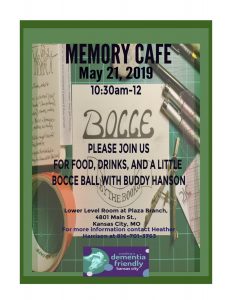
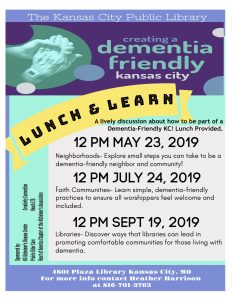
Click to view informative and inspiring short videos on our YouTube channel
Deborah Shouse is the author of Connecting in the Land of Dementia: Creative Activities to Explore Together and Love in the Land of Dementia: Finding Hope in the Caregiver’s Journey.
Animal Magnetism: The Zoo Cafe Attracts Almost 100 People!
The April 16th KC Memory Cafe started out quietly. People came in, silent, perhaps feeling a little confused or weary. After they sat down at comfortable tables and were served comforting snacks, the conversations increased. People enjoyed their oranges, animal crackers, and drinks. And then the dynamic duo from the Kansas City Zoo brought out the first attraction and the crowd got really engaged in the black and bright blue tree frog from South America. They peered through the glass container at the amphibian, tapped the glass to get his attention, and asked questions. The animal magnetism was working. 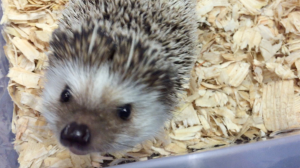
With the introduction of the African Pygmy Hedgehog, the guests became even more animated. The hedge hog was undeniably adorable and everyone wanted a good look. “Where is he from?” “What does he eat?” “Will he bite?” people asked. And “Can I have another look at him?”
When the parrot emerged from its covered cage, everyone grinned and clapped. The bird wowed the crowd by saying, “Hello,” clear as could be. When one of the educators passed around brilliantly colored feathers the parrot had shed, people avidly admired them. 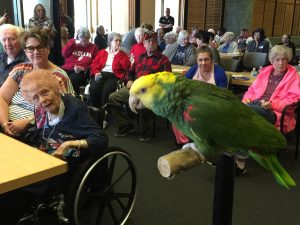
The energy was buzzing as people left, buoyed by learning about these new animals and excited by the outing.
“I will be back,” one woman promised.
“This was so well done,” a staff member told us.
“I loved the parrot,” another woman said.
What we all loved most was seeing our guests blossom and talk and come to life by experiencing such an interactive and engaging program. Many thanks to the Kansas City Zoo for sharing these remarkable educators and animals with us. And many thanks to our guests for attending. We hope to see you all at a future cafes.
Click here and enjoy watching the animal magnetism
Want to experience some animal magnetism at home?
If you have a pet, share the responsibilities of caring for it. Taking care of an animal offers a sense of purpose and invites out our nurturing spirits.
If you don’t have your own pet, invite a well behaved pet to visit. Select an animal you all like, ideally one you can pet and hold, such as a dog, cat, or bunny.
Consider adding a spill-proof aquarium, featuring brightly colored fish. Watching the fish glide by can be soothing.
Look for other opportunities to hold or connect with animals.
Come join us for our next Cafe:
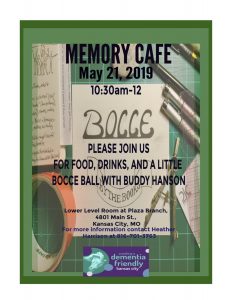
Rock Around the Library: Celebrating a Year of KC Memory Cafes
No one can sit still. Not when Little Richard, The Archies, or Dion are singing. It’s a Rock Around the Library: Celebrating a Year of the KC Memory Cafes. We are one-year-old this March and we’re celebrating with Musical Bingo by Carrieoke Productions. We’ve enjoyed ice cream and cake and we’re ready to roll, rock and roll, that is.
At the first note, one of our guest says, “Sugar, Sugar.” She’s right and a small group of us sings the literally saccharine 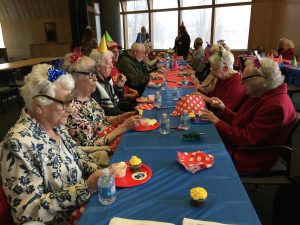 lyrics, “Sugar, ahh honey, honey, you are my candy girl…”
lyrics, “Sugar, ahh honey, honey, you are my candy girl…”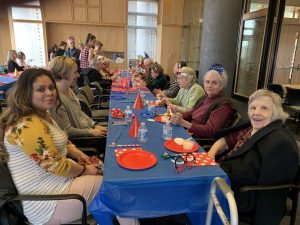
Within moments, all the care partners are dancing. We’re all helping each other find the songs on our Bingo sheets. We’re singing along when we know the lyrics and humming along when we don’t. We’re laughing.
When Carrie plays the Beach Boys’ tune, I Get Around, one guest says, “I wish I could get around.” Another chimes in, “Me too!”
For an hour, we Twist and Shout, warble Do You Want to Dance?, warn our neighbors not to “step on my Blue Suede Shoes,” and shake our heads over Run Around Sue. Those who win at musical bingo, and there are many of them, get to select a prize. 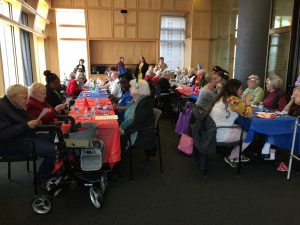
“It’s wonderful to see people blooming,” one care professional says.
And it’s equally wonderful to see the caregivers laughing, joking, dancing, encouraging, sharing, and helping us create This Magic Moment.
Click here to join the party:
Don’t miss our Magic Moment in April. The Kansas City Zoo is bringing some exotic and personable animals on April 16th.
Please join us at 10:30 on the lower level of the Plaza Library. Come early. Please share this information with anyone who might benefit.
Deborah Shouse is the author of Connecting in the Land of Dementia: Creative Activities to Explore Together and Love in the Land of Dementia: Finding Hope in the Caregiver’s Journey.
Quality Moments in the Land of Dementia: Laughing and Creativity in Jamaica
Our hosts started the program with a beautiful hymn of gratitude, a perfect way to acknowledge the spiritual aspects of connecting and laughing in the land of dementia. We met in the Salvation Army Church and Community Centre in historic downtown Falmouth, Jamaica, with a group of caregivers and community advocates. During our time together, we shared stories, information, laughter exercises, and creative ideas for taking care of ourselves and staying engaged.
 For many, this was an introduction to dementia. For others, who were in the midst of caregiving, this was a time of learning and sharing.
For many, this was an introduction to dementia. For others, who were in the midst of caregiving, this was a time of learning and sharing.
Ron and I talked about the importance of accepting each other as we are, no matter what we are going through. We discussed the power of having a purpose and how vital it is for all of us to have meaningful relationships and interesting experiences. .
”When communicating with people who are living with dementia, don’t argue,” Shirley Duncan reminded everyone. “Don’t criticize. Be there to support and appreciate.”
“When we are kind to ourselves, then we are better able to be kind to others,” one of our attendees said.
We discussed Dr. Cameron Camp’s concept of cognitive ramps, offering people the assistance they need 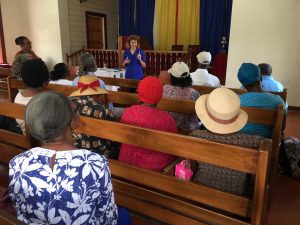 to remain engaged in the activities they love. Here’s one example from our session: Lorna’s mother was a professional cook, completely at home in the kitchen. As her dementia progressed, she could no longer remember the family’s favorite recipes. But she could sit in the kitchen and enjoy the energy of cooking. And when Lorna’s daughter said, “We are going to make your famous stew. Does it have an onion in it?” the mother smiled and nodded. Ingredient by ingredient, they consulted her, and she smiled and nodded at the mention of the right ingredients. Even though she wasn’t physically creating the meal, she was an integral part of the process.
to remain engaged in the activities they love. Here’s one example from our session: Lorna’s mother was a professional cook, completely at home in the kitchen. As her dementia progressed, she could no longer remember the family’s favorite recipes. But she could sit in the kitchen and enjoy the energy of cooking. And when Lorna’s daughter said, “We are going to make your famous stew. Does it have an onion in it?” the mother smiled and nodded. Ingredient by ingredient, they consulted her, and she smiled and nodded at the mention of the right ingredients. Even though she wasn’t physically creating the meal, she was an integral part of the process.
We talked about the power of music, sharing ideas from Dan Cohen’s Music and Memory program and introduced people to the personal playlist. We had an impromptu Conductorcise session, using Maestro David Dworkin’s aerobic and ground-breaking program, pretending we were conducting a symphony orchestra. We used laughter syllables to make it even more fun and soon everyone was standing up and conducting and laughing.
We shared a story from Karen Stobbe, reminding us all to affirm and appreciate and to use the improv technique, “Yes and…” to ignite and invite conversation.
Throughout our discussion, we wove in laughter exercises.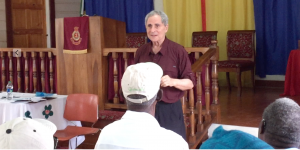
We enjoyed an imaginary laughter swim. We batted around laughter balloons and cooked up a laughter stew that included fish, pumpkin, garlic, carrots, Irish potatoes and okra.
At the end, we breathed in our gratitudes, closed our eyes and sent our feelings of love, connection, and laughter into the world, hopefully to help and inspire others.
Click here for a small taste of this lively workshop:
A special thanks for the dementia advocates and community volunteers who brought everything together, including Dundeen Ferguson, Shirley Duncan, Sandra Latibeaudiere, Elise Thomas, and Lorna Colley. And thanks to everyone who attended.
Deborah Shouse is the author of Connecting in the Land of Dementia: Creative Activities to Explore Together and Love in the Land of Dementia: Finding Hope in the Caregiver’s Journey.
